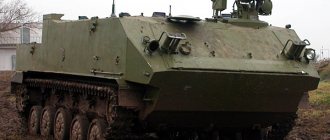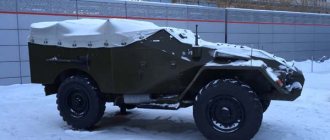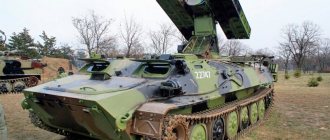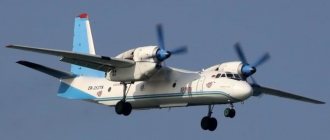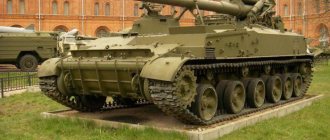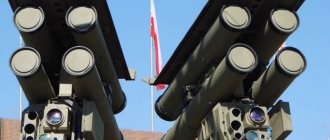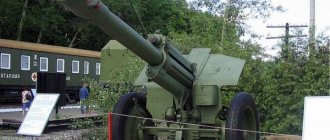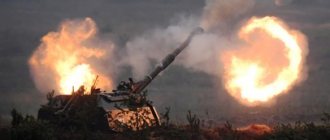This term has other meanings, see BTR.
| BTR-70 | |
| BTR-70 at the Military Glory of the Urals Museum of Military Equipment | |
| BTR-70 | |
| Classification | Armored personnel carrier |
| Combat weight, t | 11,5 |
| Crew, people | 2 |
| Troops, people | 8 |
| Story | |
| Manufacturer | |
| Years of production | since 1972 |
| Years of use | since 1976 |
| Basic operators | |
| Dimensions | |
| Case length, mm | 7535 |
| Width, mm | 2800 |
| Height, mm | 2235-2320 |
| Base, mm | 4400 |
| Track, mm | 2380 |
| Ground clearance, mm | 475 |
| Booking | |
| Armor type | rolled steel |
| Body forehead, mm/deg. | 8-10 |
| Hull side, mm/deg. | 6 |
| Hull feed, mm/deg. | 6 |
| Turret front, mm/deg. | 6 |
| Tower side, mm/deg. | 6 |
| Tower feed, mm/deg. | 6 |
| Armament | |
| Angles VN, degrees. | −5 — +30[1] |
| Angles GN, degrees. | 360 |
| Firing range, km | 2 (KPVT) 1.5 (PKT) |
| Sights | PP-61AM |
| Machine guns | 1 × 14.5 mm KPVT 1 × 7.62 mm PKT |
| Mobility | |
| engine's type | two ZMZ-4905 |
| Brand: | two ZMZ-4905 |
| Type: | twin carburetor petrol |
| Volume: | 4,250 cm3 |
| Maximum power: | 120 l. s., at 3400 rpm |
| Maximum torque: | 284.4 Nm, at 2500 rpm |
| Configuration: | |
| Cylinders: | 8 |
| Fuel consumption combined cycle: | 116 l/100 km |
| Fuel consumption on the highway: | 72 l/100 km |
| Cylinder diameter: | 92 mm |
| Piston stroke: | 80 mm |
| Compression ratio: | 6,7 |
| Clock (number of clock cycles): | 4 |
| Cylinder operating order: | 1-5-4-2-6-3-7-8 |
| Maximum speed: | 3650 |
| Recommended fuel: | Gasoline A-76 GOST 2084-67 |
BTR-70
- Soviet armored personnel carrier - a combat wheeled floating armored vehicle for transporting personnel of motorized rifle units and their fire support, including in conditions of the use of weapons of mass destruction.
The BTR-70 combat vehicle is a floating, all-round armored, eight-wheeled vehicle with independent suspension (with all drive wheels) capable of following tanks and overcoming trenches, trenches and water obstacles on the move. The armament consists of a 14.5 mm KPVT machine gun and a 7.62 mm PKT machine gun.
Content
- 1 History of creation
- 2 Serial production
- 3 Design description 3.1 Armored hull and turret 3.1.1 Power compartment
- 3.1.2 Fighting compartment
- 3.1.3 Management department
- 6.1 Modern
Production
This combat vehicle was developed by the design bureau of the Chelyabinsk Tractor Plant (ChTZ) in May - July 1942 in connection with complaints from the commanders of the Workers 'and Peasants' Red Army (RKKA) about the low mobility and reliability of the original version of the KV-1 heavy tank.
In order to reduce the total weight of the tank, its dimensions were slightly reduced and the side armor was weakened. As a result of these measures, the average and maximum speed of the tank increased, and together with the introduction of a new gearbox, it was possible to slightly increase the overall reliability of the vehicle when used by the troops. Compared to the KV-1, the armament remained the same, but the efficiency of its use increased - the tank commander’s position was equipped with an observation turret, which improved visibility of the battlefield. Production of KV-1s and KV-8s tanks at ChKZ (according to Military Acceptance data)
| Year | Model | 1 | 2 | 3 | 4 | 5 | 6 | 7 | 8 | 9 | 10 | 11 | 12 | Total |
| 1942 | KV-1s | 2* | 34 | 174 | 166** | 125*** | 125 | 626 | ||||||
| KV-8s | 6 | 9 | 10**** | 25***** | ||||||||||
| Total | 2* | 34 | 180 | 175 | 135 | 125 | 651 | |||||||
| 1943 | KV-1s | 92 | 72 | 52 | 50 | 75 | 30 | 52 | 39 | 462 | ||||
| KV-8s | 7 | 3 | 10 | |||||||||||
| Total | 99 | 75 | 52 | 50 | 75 | 30 | 52 | 39 | 472 | |||||
| Total | 1123 |
*According to reporting documents they passed as KV-1, but in fact they were experimental KV-1s, delivered by July 27 and had serial numbers 15001 and 15002.
**65 of them had KV-1 hulls.
***5 of them had KV-1 hulls.
****7 of them had KV-8 hulls.
*****all 25 tanks had KV-8 turrets.
1086 KV-1s and 35 KV-8s were produced
Description of design
2 views and drawing of BTR-70
Placement of the crew and troops inside the protected space: 1 - commander, 2 - driver, 3 - machine gunner, 4 - riflemen
The BTR-70 is an amphibious armored combat wheeled vehicle and is designed for transportation and fire support of motorized rifle units[3].
Armored hull and turret
The body of the armored personnel carrier is completely sealed, consists of three compartments, is made of steel armor plates and is the supporting structure on which all the units and mechanisms of the vehicle are installed[3].
Power department
At the rear of the hull there is a compartment of the power plant, in which two engines, a clutch and a gearbox are installed, which are mounted on one frame. The power compartment is separated from the rest of the hull by a partition in which there are hatches for access to the engines. Also in the power compartment there are fuel tanks, which are isolated from the rest of the compartment elements[4].
Combat compartment
In the middle part of the hull there is a fighting compartment, which houses a turret installation, ammunition stowages, surveillance devices and other equipment. In addition, the fighting compartment has two double three-seat and two single seats to accommodate troops[4].
Department of Management
In the front part of the hull there is a control compartment, in which the vehicle controls, surveillance devices, a winch, a radio station and workplaces for the driver and commander are located [4].
Armament
The main armament is a 14.5-mm KPVT machine gun, with a maximum firing range of 2 km. The carried ammunition is 500 rounds[5].
Additionally, the turret mount is equipped with a 7.62-mm PKT machine gun coaxial with the KPVT, the firing range of which is up to 1.5 km. Carryable ammunition - 2000 rounds[5].
Surveillance and communications equipment
The commander's observation devices include three TNPO-115 devices and one TPKU-2B; for observation at night there is a TKN-1S, on the shield of which an OU-3GA-2M illuminator is installed. The driver has three TNPO-115 installed, and also has one TPN-B; for observations at night, a TVNO-2B device is installed. The turret installation contains a PP-61AM sight, as well as a TNPT-1 observation device. The landing force has seven hatches in the hull for observation, as well as two TNP-B observation devices[6].
To provide external communications, the R-123M radio station is used, which is located to the right of the commander’s seat. For internal conversations, an intercom for three subscribers R-124[7] is used.
Engine and transmission
The power plant uses two ZMZ-4905 gasoline engines, the total power of which is 240 hp. p.[6]
The transmission has a permanently closed, damper clutch. The gearbox is mechanical, has four forward and one reverse gears. The third and fourth gears have synchronizers[8].
Chassis
The chassis is wheeled, has 8 wheels measuring 9-18″ with detachable rims. Wheel tires are pneumatic modifications K-58, size 13.00-18″, with the ability to regulate pressure depending on road conditions[9].
The vehicle's suspension is independent lever-torsion bar, which includes 8 torsion bars, 16 suspension arms, and 12 double-acting hydraulic shock absorbers[9].
Water jet propulsion
The BTR-70 is floating and has a jet hydraulic water cannon installed on it, the jet thrust of which is created by a water propeller on the principle of conventional propellers of sea and river vessels. Speed afloat 10 - 12 km/h, power reserve 12 hours.[10]
Armored personnel carriers as a type of equipment
Armored personnel carriers and infantry fighting vehicles are vehicles designed to perform a dual mission: they must transport infantry units to the battlefield and provide them with fire support. In some cases, they are used to provide cover for advancing soldiers, but this is only possible when the defending forces do not have powerful anti-armor weapons at their disposal. Otherwise, vehicles that have relatively light protection (usually bulletproof and anti-fragmentation) are doomed to be quickly hit by shells, ATGMs or hand grenade launchers.
Armored personnel carriers developed in the USSR and other countries have another drawback: they are very vulnerable to minefields. They traditionally strive to make vehicles lighter, providing them with maximum speed and firepower, as well as air mobility, and therefore the bottom has weak protection. If a landmine or anti-tank mine explodes at the moment of impact, there is a serious danger of death of the crew and all other military personnel inside the hull from compression effects. It is for this reason that during armed conflicts of recent decades (including the Afghan War), soldiers, as a rule, preferred to be on armor while marching, quite reasonably fearing enemy bullets less than insidious mines installed on the road.
When designing the new Russian armored personnel carrier "Boomerang", the designers of the Military-Industrial Company tried to level out the circumstances that impede the successful performance of the main functions of this type of weapon and expand its capabilities.
Modifications
Memorial to the Great Patriotic War on Gagarin Avenue in Nizhny Novgorod
BTR-70 in the Museum of Military Equipment "Combat Glory of the Urals", Verkhnyaya Pyshma.
BTR-70M of the 54th Guards Missile Division at the final stage of the Strategic Missile Forces competition “Strategic All-Around”[11].
- BTR-70KShM
- command and staff vehicle - BTR-70MS
- radio communication vehicle. The tower is missing, additional radio stations have been installed. - BTR-70M
is a modernized version of the BTR-70. A KamAZ-7403 diesel engine with a power of 260 hp is installed. s., instead of two gasoline engines, as well as transmission units from the BTR-80. - TAV-77
- Romanian modification
of the BTR-70 - BTR-70M
- Ukrainian modification of the BTR-70. The modernization was carried out by the Kharkov Mechanical Engineering Design Bureau named after. A. A. Morozov within the framework of the state defense order to equip peacekeeping units of the armed forces of Ukraine. Instead of two gasoline engines, a Ukrainian-made UTD-20 multi-fuel diesel engine is installed. Armament is a 14.5 mm KPVT heavy machine gun and a 7.62 mm PKT coaxial machine gun. Side hatches are similar to the BTR-80 type.[12] About twenty were released[13]. - BTR-70 "Thunder"
- Ukrainian modernization
of the BTR-70
, produced by the Kharkov Mechanical Engineering Design Bureau named after A. A. Morozov. A Ukrainian-made UTD-20 diesel engine was installed instead of two gasoline engines and a Grom combat module (1x30 mm automatic cannon, 1x7.62 mm machine gun, 1x30 mm automatic grenade launcher and Barrier ATGM with ammunition in 4 ATGMs) instead of the standard turret. Side hatches are of the BTR-80 type. One experienced one was released. - BTR-70 KBA-2
- Ukrainian modernization
of the BTR-70
, produced by the Kharkov Mechanical Engineering Design Bureau named after A. A. Morozov. A Ukrainian-made UTD-20 diesel engine was installed instead of two gasoline engines and a 30-mm KBA-2 cannon was installed instead of the KPVT machine gun. Side hatches are of the BTR-80 type. One released.[14] - BTR-70T
- Ukrainian modernization of the BTR-70. New side landing hatches, like those of the BTR-80, a R-173 radio station, and two new D245.30E2 diesel engines with a total power of 312 hp were installed. p., front and rear marker lights BTR-80, new wheels with tubeless tires. Five were released[15]. - BTR-70DI (BTR-7)
is a Ukrainian modernization of the BTR-70, produced by the Nikolaev Armored Repair Plant. The vehicle is equipped with: the Zaslon active protection complex, a television, a combined day and night sight with a laser rangefinder and a panoramic viewing system "Panorama", an automatic fire extinguishing system, air conditioning, two diesel engines FPT "Iveco" Tector (EURO-3), mechanical six-speed gearbox. Mine protection has been enhanced, 3A and 3B according to NATO classification. The fighting compartment was modernized, a 30-mm automatic grenade launcher AGS-17, and a Barrier ATGM (4 ATGMs) were installed. A 30-mm ZTM-2 automatic cannon can be installed and equipped with an unmanned aerial vehicle capable of conducting reconnaissance within a radius of about 20 km.[16] 13 and 2 KShM based on it were produced[17] - BTR-70M-A1
- Belarusian modification. Two diesel engines with a capacity of 136 hp are installed. pp., with electronic control. It is planned to install a BM-30 combat module instead of a standard turret and a 10 kW air conditioner. - BTR-70MB1
is a Belarusian modification developed by OJSC “140th Repair Plant”. Installed side landing hatches, a water-jet propulsion system, seats and transmission elements from the BTR-80, a 260 hp diesel engine. p., radio station R-173M[18] - Cobra-K
is a modification developed in 2001-2002 by the Belarusian 140th repair, and Slovak and “ZTS Dubnica”[20]. A Cobra combat module is installed, equipped with a 30-mm 2A42 automatic cannon, a PKT coaxial machine gun and an improved fire control system. The machine is equipped with a smoke system “Tucha” and a German air conditioning system DATO-V. It is planned to replace the engines with one diesel KamAZ-7403 with a power of 260 hp. With. The crew consists of 3 people and 8 infantrymen in the troop compartment. - BTR-70M
is an Azerbaijani modification, a joint development of the Baku Instrument-Making Plant, the Nikolaev Mechanical Repair Plant and the South African company EWT. A Shimshek combat module is installed, equipped with a 23-mm ZU-23 or 30-mm 2A42 automatic cannon. Mine-resistant and anti-fragmentation armor has been strengthened. - BTR-70MD
- Kazakh modification of
the BTR-70
with 2 D-235.9E2 diesel engines (2 × 135 hp), a Turkish ATS-10 thermal imager is installed [21]
What is known about "Boomerang"
In addition to the published images, the weight of the equipped vehicle is reliably known - it is 20 tons, but it is assumed that in certain modifications it can reach 25. The engine layout is rational: it occupies the front and partly the middle length of the armored hull, protecting the crew and infantrymen. The internal volume of the troop compartment is increased compared to the BTR-82 and other Soviet-designed motorized infantry vehicles. This is due to the fact that in modern conditions military personnel have more extensive equipment, including body armor. Soldiers can leave a spacious vehicle much faster than a cramped one, so increasing the size is not only a matter of comfort, but also of safety.
And she got a lot of attention
Vehicles based
- "Otsek"
- Soviet experimental 120-mm self-propelled gun - 2S14 “Zhalo-S”
is a Soviet experimental 85-mm anti-tank self-propelled gun. - 1L29 "Rtut-B"
- jamming station for SPR-2 radio fuses. - 15Y56M
- MBP combat post vehicle. - BTR-70Di-02 “Svityaz”
is a Ukrainian command and staff vehicle produced by the Nikolaev Armored Plant SE. 2 released[22]. - BMM "Ark"
is a Ukrainian armored medical vehicle produced by the Nikolaev Armored Plant SE. 6[23][24] released. - BREM-2000 (BREM-7K)
is a Ukrainian armored repair and recovery vehicle produced by the Nikolaev Armored Plant SE.[25] No release data available. Probably 1 experienced. - UDS-70
is a training stand produced by the Nikolaev Armored Plant State Enterprise. - KM-70 (BTR-MK)
is a Belarusian command vehicle, based on the BTR-70M, produced by Minotor-Service. The tower was dismantled, two radio stations R-130M and R-123M, and navigation equipment were installed. Crew 6 people. - MTP-70 (MTP-K)
is a Belarusian technical assistance vehicle, based on the BTR-70M, produced by Minotor-Service. Armed with a 7.62 mm PKT machine gun. Equipped with a traction winch, a lifting device with a lifting capacity of 1.5 tons, and electric welding equipment. Crew 4 people.
Weapon
This infantry vehicle is very seriously armed.
The first thing that any military observer usually pays attention to, out of old habit, is the turret gun. In the standard version, announced in the press, it is rapid-fire (2A42), has a caliber of 30 mm and is controlled remotely
However, there is also information that there are prototypes of the Boomerang armored personnel carrier with a 57-mm automatic cannon. The robotic combat module, isolated from the crew, also includes a 7.62-caliber PKTM machine gun and two Kornet launchers capable of hitting targets at a distance of up to 10 km. The weapons are controlled by an automated control system that searches for targets (including camouflaged ones) automatically in any weather and light conditions.
There is also a variant in which the rapid-fire artillery gun is replaced by a 12.7 mm machine gun, which also has computerized control.
Operators
BTR-70 left-front. Kazan. 2009
BTR-70 rear left. Kazan. 2009
BTR-70 on the left in Victory Park. Kazan. 2009
Modern
- Azerbaijan Azerbaijan: Army of Azerbaijan - 132 BTR-70, as of 2020[26]
- Azerbaijani border troops - 19 BTR-60, BTR-70 and BTR-80, as of 2020[27]
- Internal troops of the Ministry of Internal Affairs of Azerbaijan - 7 BTR-60, BTR-70 and BTR-80, as of 2020[27]
- Armenian Army - 18 BTR-70, as of 2020[28]
Former operators
- Afghanistan Afghanistan - a number of BTR-70s, as of 2010[48]
- Bosnia and Herzegovina Bosnia and Herzegovina - 3 BTR-70, as of 2010[49]
- Hungary Hungary - 309 BTR-70[50][ unauthoritative source?
] - GDR GDR - 1266 BTR-70 units delivered from the USSR between 1983 and 1990, used under the designation SPW-70[51]
- State of Palestine State of Palestine - 50 BTR-70 with weapons removed, delivered in 2010 from Russia as humanitarian aid[51]
- Kazakhstan Kazakhstan - 190 BTR-70 and BTR-80, as of 2012[52], according to other sources 45 BTR-70[50][ unauthorized source?
] - Moldova Moldova - 20 BTR-70[50][ unauthorized source?
] - Nepal Nepal - 135 BTR-70[50][ unauthorized source?
] - Romania Romania - produced under license under the designation TAB-77, 159 units were produced between 1978 and 1991, after the collapse of the USSR production continued under license[51], as of 2012 Romania has 150 TAB-77[53]
- USSR USSR - passed to the states formed after the collapse
- Sudan Sudan - 10 BTR-70M Cobra delivered in 2007 from Belarus[51][54]
- USA USA - 7 BTR-70 units were supplied from Germany (5 BTR-70 in 1991, 2 more in 1993)[51]
- Republic of Abkhazia Republic of Abkhazia - 86 BTR-70 and BTR-80, as of 2007[55][ non-authoritative source?
] - South Ossetia South Ossetia - 90 BTR-70 and BTR-80 in the Ministry of Emergency Situations, as of 2008[56]
Platform versatility
From the very beginning (development supposedly began in 2010), the new Russian armored personnel carrier “Boomerang” was created not just as a means of delivering infantry and its fire support. It should become the basis (platform) on which the technical ability to produce machines for various purposes is provided, and, if necessary, it should also have the potential for rapid re-equipment by changing modules. On the basis of the chassis, it is planned to produce anti-tank mobile systems, evacuators of the wounded, front-line reconnaissance, air defense and electronic warfare equipment. This is why the images of the secret car that have become available to the media are different. The new Russian armored personnel carrier "Boomerang", the photo of which sometimes shows the absence of a turret or the presence of some devices of unknown purpose, can have a wide variety of configurations.
Service and combat use
- Afghan War (1979–1989)[57]
- Armed conflict in Transnistria - 10 BTR-70 armored personnel carriers of the Moldovan army were captured as a trophy by the Transnistrian armed forces in May 1992 in battles[58].
- Georgian-Abkhaz conflict
- Russia, Chechnya - Chechen wars (1994-1996, 1999-2002)
- Georgian-South Ossetian conflict[59]
- Yugoslav wars[60]
- The only state from the NATO bloc that acquired and used the BTR-60PB in combat conditions is Turkey. After the unification of Germany, the Turkish authorities purchased BTR-60PB and BTR-70 from the arsenals of the disbanded NPA of the GDR and used them in combat operations against Kurdish rebels. Based on positive assessments of the data by the Turkish military, Turkey purchased a large batch of BTR-80 BTR-80s from Russia in 1996.[61]
- Armed conflict in eastern Ukraine (2014 - present).
Notes
- Armored personnel carrier BTR-70. Technical description, page 16
- ↑ 12
Domestic wheeled armored personnel carriers BTR-60, BTR-70, BTR-80, p. 38 - ↑ 12
Armored personnel carrier BTR-70. Technical description, page 5 - ↑ 123
Armored personnel carrier BTR-70. Technical description, page 7 - ↑ 12
Armored personnel carrier BTR-70. Technical description, page 15 - ↑ 12
Armored personnel carrier BTR-70. Technical description, pp. 16-17 - Armored personnel carrier BTR-70. Technical description, page 30
- Armored personnel carrier BTR-70. Technical description, page 20
- ↑ 12
Armored personnel carrier BTR-70. Technical description, page 22 - Infantry combat transport. N. Aleshin, V. Sergeev, V. Brovkin. Modeler-constructor. — 1985 No. 10
- The “Strategic All-Around” competition has started in the Strategic Missile Forces formations. Department of Information and Mass Communications of the Ministry of Defense of the Russian Federation
(06/16/2016). Retrieved November 9, 2020. - Morozov Design Bureau modernized the BTR-70 armored personnel carrier
- Motor hunger: The Ukrainian military-industrial complex is faced with a lack of engines for equipment // “AUTO-Consulting.UA” dated March 11, 2015
- Modernization of armored personnel carriers BTR-70 and BTR-80 (inaccessible link) / official website of KMDB
- Techimpex Virobnitstvo
- BTR 70 Di (BTR 7)
- Sergiy Voronkov. Life lessons from Mikolaiv repairmen Archived on May 13, 2012.
- reserve lieutenant colonel Nikolai Makarevich. A plant that can do everything // “For the glory of the Motherland,” No. 133, July 21, 2015
- reserve lieutenant colonel Nikolai Makarevich. Success comes to those who know how to work reliably and efficiently // “For the glory of the Motherland,” No. 81, April 30, 2013
- Valery Kovalev. “Cobras” come into play... // “Red Star” dated October 25, 2001
- Kazakhstan demonstrated the modernized BTR-70MD / TsAMTO
- Victoria Tonkovid. Nikolaevsky mechanical repair shop: they know how to work here // newspaper “Evening Nikolaev” dated June 1, 2012
- « Pershu BMM-70 in Lipny 2014
transferred to the 79th Airmobile Brigade. The 28th mechanized brigade took such a machine from a friend of mine. Usyogo has produced six BMM-70s .” E. M. Kazan. Before feeding about the protection of the armed forces of Ukraine with armored medical vehicles // Collection of theses of the International Scientific Conference “Prospects for the development of armored and modern technology of ground forces” (18-20 May 2020) / Lev iv, Drukarnya National Academy of Land Forces. Hetman Petro Sagaidachny, 2020. page 32-33 - Vitaly Andronatiy. Viyna decided to turn her faces to the medical care of the armored forces. // “Defense Express”, No. 11, 2014. page 18-23
- Repair and recovery vehicle
- The Military Balance 2020. - P. 180.
- ↑ 12
The Military Balance 2020. - P. 181. - ↑ 123
The Military Balance 2020. - P. 178. - The Military Balance 2020. - P. 183.
- The Military Balance 2020. - P. 184.
- The Military Balance 2020. - P. 476.
- The Military Balance 2020. - P. 187.
- The Military Balance 2020. - P. 135.
- The Military Balance 2020. - P. 455.
- The Military Balance 2020. - P. 405.
- The Military Balance 2020. - P. 274.
- The Military Balance 2020. - P. 280.
- The Military Balance 2020. - P. 406.
- The Military Balance 2020. - P. 194.
- The Military Balance 2012. - P. 349.
- The Military Balance 2020. - P. 354.
- The Military Balance 2020. - P. 202.
- The Military Balance 2020. - P. 203.
- The Military Balance 2020. - P. 208.
- The Military Balance 2020, p.206
- The Military Balance 2020. - P. 206.
- The Military Balance 2010. - P. 356.
- The Military Balance 2010. - P. 179.
- ↑ 1234
Army Guide - BTR-70, Wheeled armored personnel carrier - ↑ 12345
Stockholm Internation Peace Research Institute – Arms Transfers Database - The Military Balance 2012. - P. 255.
- The Military Balance 2012. - P. 148.
- The Military Balance 2020. - P. 471.
- Segodnya.ru - Why Georgia will lose the future war
- Ossetian radio and television – Armed Forces of South Ossetia
- ARMORED VEHICLES IN AFGHANISTAN (1979-1989) Archived June 21, 2012.
- Vitaly Moiseev.
Tanks in Transnistria (Russian). Retrieved May 16, 2012. Archived May 31, 2012. - Open secret
- War in Macedonia: Slavs against Albanians
- The Turkish army is arming itself with Russian military equipment
Literature
- Turchin M.A., Murashkin E.M., Stepnov V.L., Volkhonsky E.S., Lazarev V.G., Liokumovich L.Ya., Stolyarov N.V., Sergeev I.N., Brovkin B N., Sintsov Yu.L., Timonin D.A., Kiselev P.A., Vinogradov I.A., Kakorin V.B., Karpunin N.F., Bazhenov M.D., Tikhomirov V.N. .
Armored personnel carrier BTR-70. Technical description and operating instructions / Kitaev A.N. - Stereotypical. - Moscow: Military Publishing House, 1988. - 560 p. — (13/4653(b)). - Domestic wheeled armored personnel carriers BTR-60, BTR-70, BTR-80 // “Armored collection”. Supplement to the magazine “Modeler-constructor”: Magazine. - Moscow: JSC Editorial Board of the Magazine "Modelist-Constructor", 2007. - Issue. Special issue. - No. 1. - P. 38.
Surviving copies
To this day, only one completely authentic KV-1s tank has survived; two more surviving tanks are experimental and transitional versions of the “high-speed” modification from the KV-1.
- In 2006, in the city of Kirovsk (Leningrad Region), a KV-1s tank, raised from the bottom of the swamp and restored along the hull (but practically without the right track tracks), was installed.
- A tank with the signature “KV-1S” is on display in the open-air museum on Poklonnaya Hill (Moscow).
- Another KV memorial tank in the village. Parfino of the Novgorod region, released in 1942, is a transitional version from the KV-1 to the KV-1s: the armored hull of the former was used, and the turret and a number of chassis elements were used from the latter.
- The experimental tank KV-1s (aka “Object 238”
or
KV-85G
), whose standard 76-mm cannon was replaced with an 85-mm gun, is exhibited at the Armored Museum in Kubinka near Moscow.
